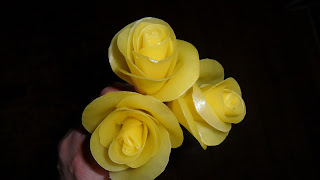Just recently I've heard a lot about neonicotinoids and the effects they are having on honey bees and other insects. People tell me how outraged they are that they have not been banned in the UK yet. Today I was approached by several people wanting to share how much they support beekeepers, like myself, by wanting to demand a ban on neonicotinoids. These are good people, caring people but people misled by media hype and political tacticians.
There is no conclusive evidence that neonicotinoids used as pesticides kill bees. More research is being carried out but if they really were as bad as the media made out, surely the scientists would have noticed? Or beekeepers would have conclusive proof instead of anecdotal? The Chemicals Regulation Directorate are concerned about the plight of insects and do much to ensure that bee are not harmed. They would never have allowed the use of neonicotinoids if they were as harmful as the media have recently been suggesting.
What would happen if neonicotinoids were banned? People need food. There are more of us to be fed and less farmed land. There is also a demand for food to be cheap. Without pesticides more people would starve and food prices would soar. It's not a realistic idea. Neonicotinoids may be banned in the future if the ongoing research proves they are as dangerous as the media would have us believe. If they were banned, what would be used instead? They are certainly not as dangerous to bees as some of the pesticides used in the past. Would we have to return to using those?
Regulation of pesticides is a complex business. No only the product but the way the product is used is regulated. On most farms, specialists are contracted to do the job. In Nottinghamshire, where I live, beekeepers have an excellent relationship with farm spray contractors, via the Nottinghamshire Beekeepers Spray Liaison Officer, a beekeeper in a voluntary role that spray contractors contact in advance if there is any danger of bees being harmed by there activities. Harm is minimised by spray contractors working very early in a morning or late at night when flying insects (like bees) are not about.
Does the average gardener take that much care when spraying pesticides on their flowers? A few do, but not many. The average gardener can also buy much more dangerous pesticides to use in their gardens than can be used on farm crops.
The number of bees of all kinds has been in decline over the last few years. People need to be concerned. The media are doing a good job highlighting the decline. The reasons for the decline are still not fully understood. More research is needed. The media is not doing a good job of telling people this.
If you are concerned about the effects of pesticides on bees and want to write to the government about your concerns, ask for more research, not a ban on a product that may be much safer to bees than any alternative. Think what's in your own garden shed and that of your neighbours. Think about the time of day you or you neighbours use pesticides in your garden.
For more honey bee information go to
www.bbka.org. Their 'Adopt a beehive' scheme raises money for research and training.
A couple of my bees foraging yesterday.










